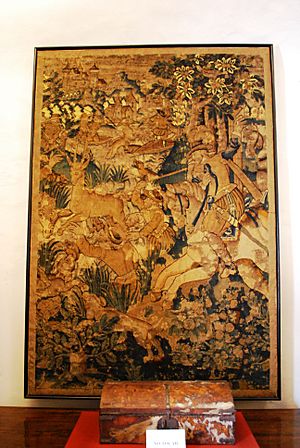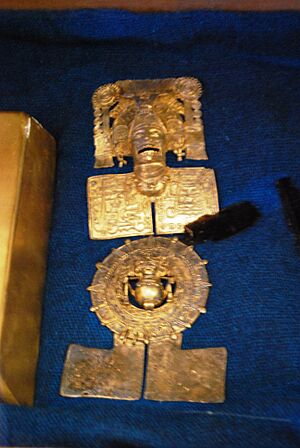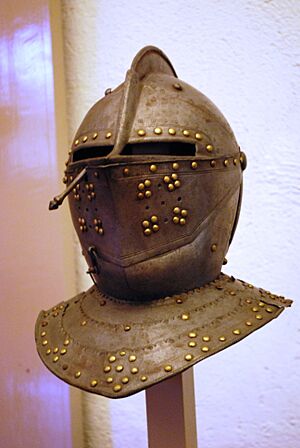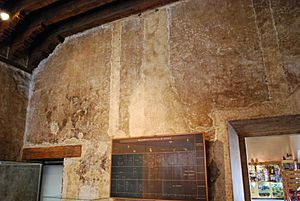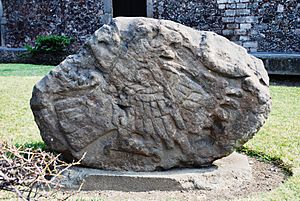Palace of Cortés, Cuernavaca facts for kids
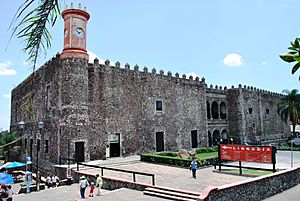
The Palace of Cortés (Spanish: Palacio de Cortés) is a very old and important building in Cuernavaca, Mexico. It was built between 1523 and 1528. This makes it the oldest civil building from the time of Spanish rule that is still standing in the Americas.
The palace mixes two old building styles: Gothic and Mudéjar. These styles were popular in the early 1500s when Spain started building in Mexico. It began as a strong home for the Spanish conqueror Hernán Cortés and his wife, Doña Juana Zúñiga.
Cortés built his palace in 1526. It was placed right on top of an old Aztec building. This Aztec building was used to collect taxes (called tribute) from the Tlahuica people. The Spanish destroyed the Aztec building during their conquest. Cortés built his home there to show his power over the people he had just conquered.
The palace was most important as Cortés's home in the 1530s. But his family later left it because of legal problems. Much later, in the 1700s, the building was fixed up. It was then used as a place for soldiers and a jail. During the Mexican War of Independence, important prisoners like José María Morelos y Pavón were held there.
After the war, the palace became the main government building for the state of Morelos. This lasted until the late 1900s. Then, the government moved out. The old palace was fixed again and turned into a museum. It was called the Museo Regional Cuauhnahuac. It showed the history of the Morelos region.
The palace was badly damaged by an earthquake in 2017. It was closed for repairs for a long time. On March 30, 2023, it reopened. It is now called the Museo Regional de los Pueblos de Morelos, which means the Regional Museum of the People's of Morelos.
Contents
The Palace of Cortés: A Historic Mexican Building
A Look Back: The Palace's Story
From Aztec Center to Cortés's Home
Long ago, before the Spanish arrived, there was a special place here. It was where the Tlahuican rulers collected tribute (taxes). Later, the Aztecs took over this area in the 1400s. They also used this spot to collect tribute.
In 1526, after the Spanish took control of the Aztec Empire, Hernán Cortés arrived. He ordered the old Aztec building to be destroyed. Then, he built a grand palace for himself in its place. Cortés chose Cuernavaca because the land around it was very fertile and good for farming.
A Fortress and a Family Residence
The first palace was smaller than what you see today. The middle part of the building, with its arched balconies, is from Cortés's original design. It was built like a fortress. It had thick walls, special battlements (merlons), and other defenses. It even had its own storage for weapons like muskets and cannons.
Most of the building was a home, though. It had a mill, stables, gardens, and ovens. The main part of the palace had two sections with four arches on each of its two floors. Living areas were built on the north and south sides. A watchtower was added when Cortés became the Captain General and Governor of New Spain. Cortés made sure his home was richly decorated. The walls had many tapestries, and the chapel had gold and silver religious items.
Cortés needed protection because the newly conquered people sometimes attacked. Once, Tlahuican warriors tried to kill him near a place now called "Devil’s Alley." This attack is a true story. A later legend says Cortés escaped by jumping a wide gap on his horse, Rucio.
Cortés brought his second wife, Doña Juana de Zúñiga, to live in the palace. She stayed there even after Cortés died in 1547. Their son, Don Martín Cortés, 2nd Marqués del Valle de Oaxaca, was born in this palace. However, Cortés himself didn't spend much time here. He was busy exploring, building ships, and managing his lands. He also brought new crops like sugar cane to the area. Cortés had three large farms (haciendas) near Cuernavaca. He often spent more time at these farms than at the palace.
The palace was most important as Cortés's home in the 1530s. He visited it often. The first time it was made bigger was between 1531 and 1535. This was when Cuernavaca became the main office for Cortés's lands. In 1540, Cortés went to Spain and could not return to Mexico. He died in Spain in 1547.
Changing Hands: Barracks, Jail, and Government
After Cortés died, his son Don Martin inherited the palace. From 1629 to 1747, the family slowly stopped using it. The building was then used for different jobs. It became a place for making iron, tanning leather, and weaving cloth.
In the mid-1700s, the Spanish government ordered the old building to be fixed. Three architects worked on the design. After it was repaired, the government used it as a place for soldiers and a jail. During the Mexican War of Independence, famous prisoners like José María Morelos y Pavon and Ignacio López Rayón were held here. Some mayors of Cuernavaca might have also lived in part of the building.
In 1855, the palace was used by the temporary government of Juan Álvarez. He was a Mexican leader fighting against Antonio López de Santa Anna. From 1864 to 1866, it was a summer home for Emperor Maximilian. He often visited Cuernavaca. In 1872, the palace became the main government building for the state of Morelos. That same year, Governor Francisco Leyva made the north end bigger. He also updated the stairs and other areas in a popular French style. The palace was the state government's home for about 100 years.
Modern Updates and Famous Art
Over time, the palace needed repairs because of age and earthquakes. A tall, round tower on the northwest corner was added during the late 1800s. More repairs were done in the late 1920s. In 1930, the famous artist Diego Rivera painted beautiful murals on the second-floor arches. In 1949, a new section for offices was added.
Between 1971 and 1973, experts worked to bring back the palace's original look from the 1500s. They used old building methods and studied the ancient parts. Modern materials were also used to make some sections stronger.
Exploring the Museum Today
After being restored in the 1970s, the building became the Museo Regional Cuauhnahuac. On March 30, 2023, it reopened as the new Museo Regional de Los Pueblos de Morelos. This museum is one of many in Mexico that focus on local history. It shows how the Morelos region played a part in Mexico's story.
The museum is both a history and an archeology museum. This is because of its collections, the old building it's in, and the ancient site it sits on. The museum has many rooms filled with objects from Morelos's history. These range from the first people who lived there to today.
What You'll See Inside
Many rooms show items from prehistoric times and before the Spanish arrived. You can see fossils of mammoths, maps of ancient migrations, and old pottery and stone tools. The most important ancient site shown is Xochicalco. But there are also items from other Tlahuica and Mexica (Aztec) sites in the state.
There are a few rooms about the colonial period. These include religious items, things related to Hernán Cortés, and objects from trade between Mexico and Asia. The exhibits after Mexico's independence mostly show the history of large farms (haciendas). These farms produced sugar, especially during the time of Porfirio Díaz and the Mexican Revolution. There are also displays about modern-day Morelos, like local crafts and traditions.
On the second floor, you can see a huge mural painted by Diego Rivera in 1930. It's called "The History of Morelos, Conquest and Revolution." This mural was fixed up and protected in the 1990s. In the old Congress Hall, there are also artworks by Salvador Tarajona from 1938.
The Amazing Colonial Architecture
The palace is built on a small hill in the middle of the city. It stands on the ruins of an old "tlatlocayacalli." This was a place where tribute was collected, first by the Tlahuica rulers, then by the Aztecs. The Spanish often built their important buildings on top of indigenous ones they had destroyed. Most of these Spanish buildings were churches. The Palace of Cortés is one of the few civil buildings built this way. The first building was small, with four rooms around a courtyard and arches. It was designed like the Alcázar de Colón in Santo Domingo, Dominican Republic.
Today, the larger building belongs to the Mexican government. Experts say it is in good condition. At almost 500 years old, it is the oldest preserved civil building from the colonial era in Mexico. The building is made of local stone. It uses the old pre-Hispanic structure as its base. It has battlements (merlons) for defense, which was common back then. There is a round tower on the northwest corner, but this was added much later, in the late 1800s. Some local stories say there are secret tunnels between the palace and the cathedral. However, no tunnels have ever been found. Similar stories are common in other parts of Mexico with large old buildings.
Digging Up the Past: The Archeological Site
The archeological site of the Palace of Cortés is very large. It goes from under the palace itself to the city's main square. The palace was built over a "tlatlocayacalli," a place where tribute was collected. This was first for the Tlahuica rulers and later for the Aztecs. This tribute house was probably very big and fancy because the city-state was powerful. The Spanish destroyed it and built their own structure to show their power. You can best see parts of the old Tlahuica/Aztec structure in front of the palace and in its courtyards. It is one of the few Aztec palaces that archeologists have dug up. However, not much of the original building remains after Cortés destroyed it.
When the palace was renovated in the 1970s, archeologists did a lot of work. This work was led by Jorge Angulo Villaseñor. They dug around and under the building. They found many old walls, floors, burials, and other things from the Tlahuica time to the colonial era. The best-preserved areas are in front of the building and inside the courtyards. Important artifacts were found from the Teopanzolco period. These were under items from the Aztec period. Both of these are covered by the colonial building. These discoveries helped experts understand the timeline of the Tlahuica period in Cuernavaca. Since then, more digging has found even more ancient ruins.
See also
 In Spanish: Palacio de Cortés para niños
In Spanish: Palacio de Cortés para niños
- List of oldest buildings in the Americas





